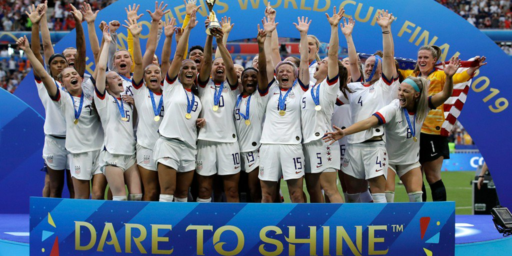Do Women Shy Away from Competition?
An interesting question posed by some NBER researchers.
The proportion of women in highly paid executive positions and in the professorial ranks of academic science and engineering is low relative to the proportion of women in the labor force. A number of explanations for this difference have been advanced. If women do not enjoy the kind of work involved in high profile managerial positions or scientific careers, or if the long working hours required in these careers conflict with the ability to raise children, then women may avoid them. Because women on the whole are less likely to be in the highest scoring group on tests of mathematical achievement, they also may be less likely as a group to be successful in competitive science and engineering positions that reward mathematical talent. Some also have argued that past discrimination has kept women from highly paid executive and academic positions, and that women subsequently avoided those careers simply to escape discrimination.
In Do Women Shy Away From Competition? Do Men Compete Too Much? (NBER Working Paper No. 11474), co-authors Muriel Niederle and Lise Vesterlund consider another possibility, that women as a group dislike competition more than men, even if they are of the same ability. If women seek to avoid competition, then they may be less successful in obtaining promotions and more lucrative jobs.
To test their hypothesis, the authors put 80 paid volunteers through a series of short tasks compensated either on a competitive winner-take-all or on a non-competitive piecework basis. In each trial, groups of four participants, always two women and two men, were given the job of finding the correct sum for as many sets of five two-digit numbers as they could in five minutes. The payment for the first task was awarded on a non-competitive basis by paying a piece rate of 50 cents for each correct answer. Payment for the second task was a competitive winner-take-all “tournament.” Losers received nothing and the person in each group with the largest number of correct answers was awarded $2 per correct answer. For the third task, participants chose either piecework payment or the tournament compensation.
Men and women answered the same number of problems correctly under both compensation systems. But when allowed to choose compensation rates for the third task, 75 percent of the men chose tournament compensation while only 35 percent of the women did so.
What is particularly interesting is that even high ability women are less likely to chose the competitive tournament than men. Of course, it is also possible that the reason men are more likely to select the competitive tournament is that they feel more confident in their abilities than they reasonably should. This was hinted at in the research where men were more likely to believe they had won the tournament. Another explanation is that women are more risk averse. Definitely something to keep in mind when discussing social policy in regards to such things as the number of women in top management positions as well as academia.





This is obviously male bullying and sexist. Head to head competition is a sexist ploy to disenfranchise women. LOL
Stuff like this is always interesting, because it provides a window not only into whatever phenomenon is being studied, but also into the attitudes of the people who read the research and comment on it.
sarcasm on>
After all, what if men and women are really (gasp) wired differently? That COULDN’T be correct, so there must be a flaw in the research design.
Would the same hold true at $50 in place of $.50, I wonder? It is easy to take risks over $2.00; it might be less easy at $200, much less $2,000.
Steven,
Interesting point, but it is $2 per right answer, so the amounts could be as high as $200.
Risk aversion rings true in the evolutionary sense of offspring-bearing female vs. wild-oat-sowing male. He has less to lose and so is “wired” to take more chances.
Sissy,
As a huge fan of evolutionary theory and its impact on economics this makes quite a bit of sense to me.